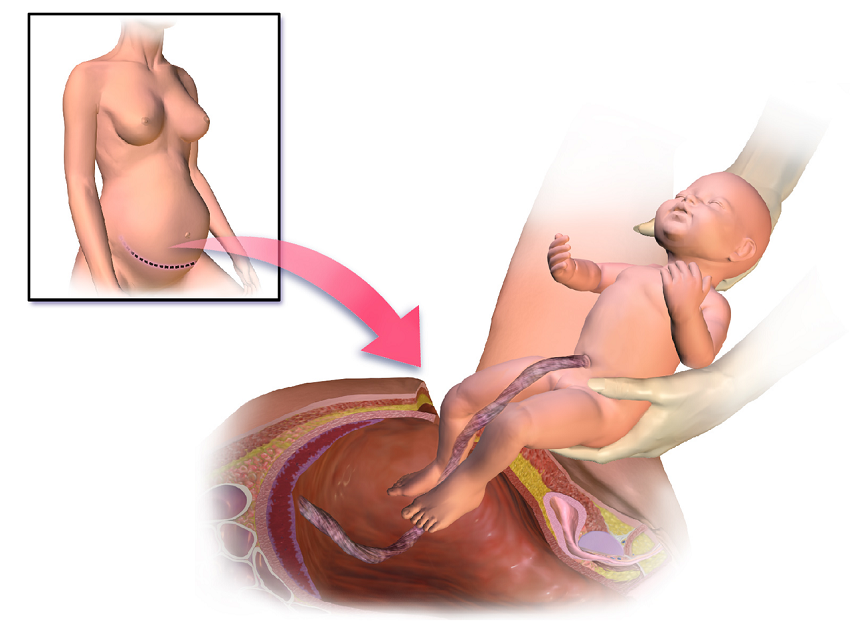Cesarean Delivery – Reasons and Complications

Cesarean Delivery or Cesearean Birth is defined as the delivery of a baby through surgical incisions made through the abdominal uterine wall. It is often called a C-Section. In most of the cases, a woman can be awake during the birth and be with her newborn soon afterward.
If a women is pregnant, chances are good that she will be able to deliver baby through the birth canal or natural delivery. But there are cases when a C-section is required for the safety of the mother or baby.
Cesarean Delivery
Cesarean deliveries are performed to separate the mother and the fetus in an attempt to save the fetus of a moribund patient. This operation subsequently developed into a surgical procedure to resolve maternal or fetal complications not amenable to vaginal delivery.
A C-section may be planned or unplanned. In most of the cases, doctors do cesarean sections because of problems that arise during labor.
Following reasons need a C-section :
- Labor is slow and hard or stops completely.
- The baby shows signs of a very fast or slow heart rate.
- A problem with the placenta or umbilical.
- The size or weight of the baby is too over to be delivered vaginally.
- The baby is not in a head-down position close to the due date.
- Women has a problem such as heart disease that could be made worse by the stress of labor.
- Women is carrying more than one baby.
- Women had a Cesarean Delivery before, and she have the same problems this time too.
In some cases, a woman who had a Cesarean Delivery in the past may be able to deliver her next baby through the birth canal. Doctor’s consultation is necessary.
Risks of C-section
It is important to know and understand the risks before a cesarean procedure, so that a woman may feel equipped to talk with her health care provider/ Doctor and make informed decisions.
Most mothers and babies do well after C-section. But it is major surgery, so it carries more risk than a normal vaginal delivery.
Some possible risks of C-section include:
- Infection of the incision or the uterus.
- Heavy blood loss.
- Blood clots in the mother’s legs or lungs.
- Injury to the mother or baby.
- Problems from the anesthesia, such as nausea, vomiting, and severe headache.
- Breathing problems in the baby if it was delivered before its due date.
C-Section
Major Risk and Complications during and after C-Section:
Pain
The main disadvantage of caesarean birth is pain after the operation. Women is likely to have pain in the wound and discomfort in her belly for at least a few weeks after the operation.
Infection
Before a Women go into surgery she offered a single dose of antibiotic to reduce the risk of infection. However, about eight per cent of women still go on to get an infection after a caesarean birth.
The uterus or nearby pelvic organs such as the bladder or kidneys can become infected.
There are three main infections to be aware of:
Infection in wound: Signs of wound infection include redness, discharge, or worsening pain in the wound.
Infection of the lining of uterus: This is called metritis. It is more likely to happen if Women’s waters broke a while before labour started or if she had lots of vaginal examinations before her caesarean. Heavy, smelly bleeding and fever can be signs of this infection.
Urinary tract infection: Women will have to have a thin tube, or catheter, inserted during the operation to empty the bladder and this can be a route for infection.
Increased blood loss:
There is more blood loss in a cesarean delivery than with a vaginal delivery. This can lead to anemia or a blood transfusion.
Formation of Blood clot
Any surgery raises the chances of developing a blood clot. If the clot lodges in the lungs it can even be dangerous. Signs of a problem include a cough or shortness of breath or pain or swelling in the calf.
The medical team give the women blood-thinning drugs, and elastic support stockings to improve the blood flow in her legs. She also be encouraged to get up on your feet as soon as possible after her caesarean. This will help in blood circulation and reduce the risk formation of Clot.
Adhesions Problem
Adhesions are bands of scar tissue which can make organs in the abdomen, stick to each other or to the inside of the tummy wall. About half of women who have had a caesarean have adhesions.
Adhesions can be painful because they limit the movement of Women’s internal organs. Occasionally, adhesions can lead to problems with fertility, as they can press on or block fallopian tubes.
Scar tissue may form inside the pelvic region causing blockage and pain. This can also lead to future pregnancy complication such as placenta previa or placental abruption.
Anaesthetic problem
Most caesareans are done without a general anaesthetic. Instead, an epidural or a spinal will numb in the women’s belly. However, having any anaesthetic involves a small risk.
Decreased bowel function:
The bowel sometimes slows down for several days after surgery, resulting in distention, bloating and discomfort.
Longer hospital stay and recovery time:
Three to five days in the hospital is the common length of stay, whereas it is less than one to three days for a vaginal birth.
Nerve damage risk:
This rarely happens and, if it does, it usually only lasts for a few days or weeks.
Medicine Reaction:
There can be a negative reaction to the anesthesia given during a cesarean or reaction to pain medication given after the procedure.
Risk of additional surgeries:
Such as hysterectomy, bladder repair or another cesarean.
Emotional reactions after Cesarean:
Women who have a cesarean report feeling negatively about their birth experience and may have trouble with initial bonding with their baby.



